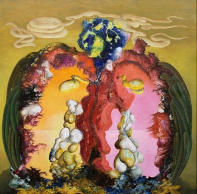



All texts copyright Richard Shillitoe
gorgon
1946
Oil on board.
22¾ x 22¾in. (57.8 x 57.8cm.)
Provenance
Private collection.
Exhibited
London, Redfern Gallery, 1946, no. 80.
London, Mayor Gallery, 1947, (paintings), no. 11.
Bradford, Cartwright Hall, 1952.
Cambridge, Heffer Gallery, 1953, no. 12, as 1947.
Penzance, Newlyn Gallery, 1961, no. 18.
Penzance, Newlyn Gallery, 1976, no. 17.
Manchester, City Art Gallery, 2009, no. 36, ill. col. p. 121.
Edinburgh, Arusha Gallery, 2019.
Literature
Remy, 1978, ill. b/w p. 5.
Remy, 1999, discussed p. 313.
Ratcliffe, 2007, ill. col. pl. 74.
The principal technique is decalcomania although combing and conventional brush-work have also been
used. The counterpart survives.
In Greek mythology there were three Gorgons. They were sisters and their gaze was so terrifying that a
mortal who looked into their eyes was turned to stone. Medusa was the chief, and the only one who was
mortal. She was beheaded by Perseus, aided by Athena and Hermes.
For Freud, Medusa symbolised castration fears. Medusa’s hair, usually depicted as writhing serpents,
represents the penis. It derives from the time when a young boy catches sight of the female genitals
surrounded by hair.
The painting has the same formal structure as Guardian Angel and Moment of Death, (both 1946). Gorgon,
however, is less a guardian angel, so much as an exterminating angel. The feathery wings, or gaping
feathered cape, is flung apart to reveal – what, exactly? Fallopian tubes; ovaries; a cloaca spewing eggs;
strings of viscera; sliced putrefying fruit, a breeding ground for spores and other accretions encroaching
from the edges. Alternatively, it is a gigantic portal dominating the landscape beyond which lies a dazzling
infinity. The image is topped by swirling serpents. The face, too terrible to gaze upon, is an unmodified,
decalcomania blot.


















